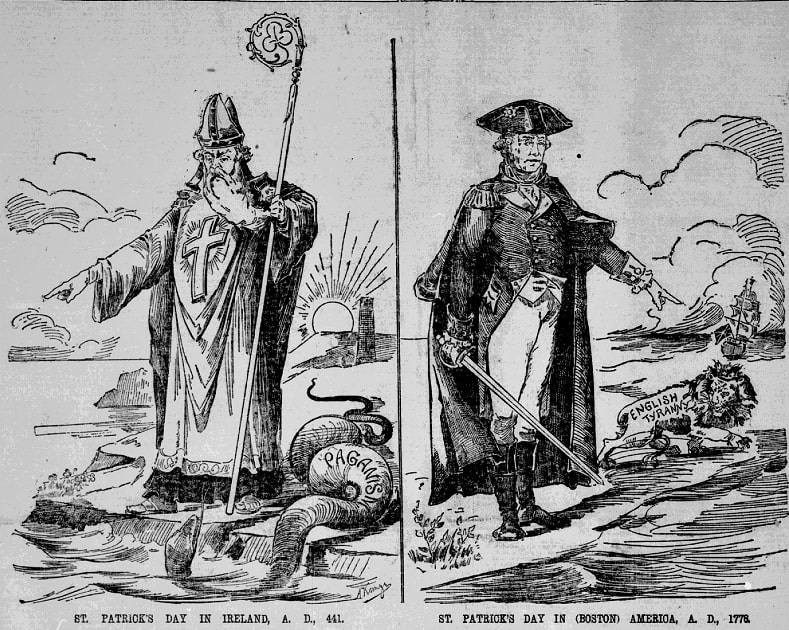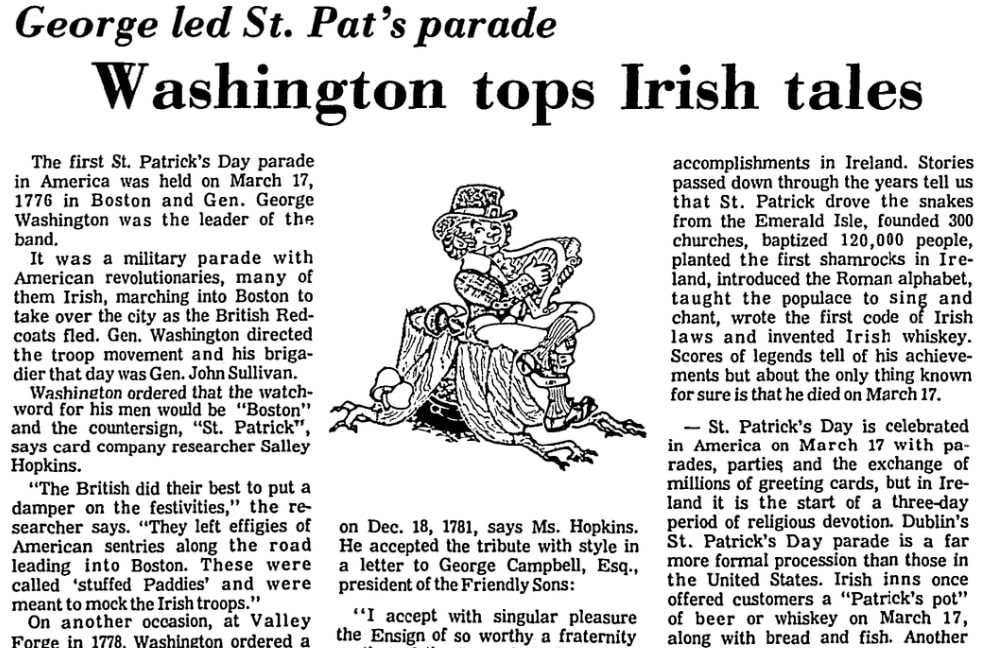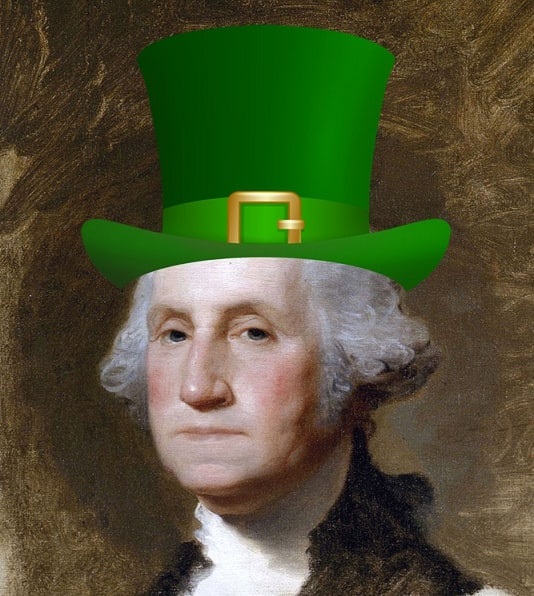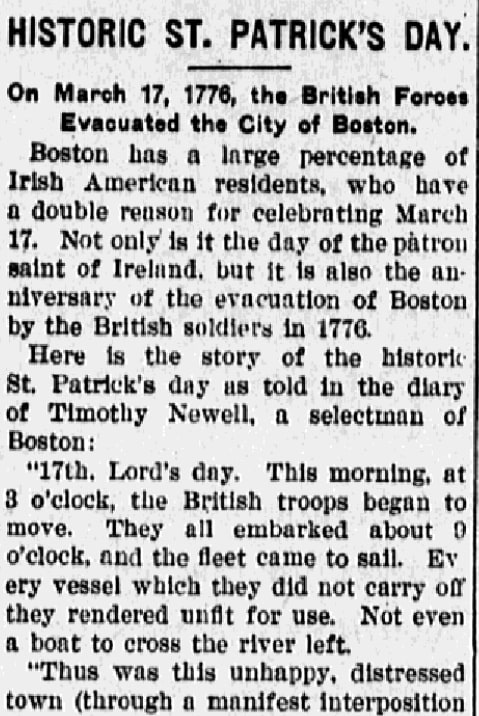Introduction: In this article, Melissa Davenport Berry explains why the St. Patrick’s Day parade in Boston every March 17 has special meaning for the city. Melissa is a genealogist who has a blog, AnceStory Archives, and a Facebook group, New England Family Genealogy and History.
Why does Boston have a dual celebration parade on March 17 every year? The St. Patrick’s/Evacuation Day Parade pays homage to the patron saint of Ireland and celebrates American liberty – which the Irish played a large hand in.

The victory won by General George Washington over the British on St. Patrick’s Day, 17 March 1776, has an auspicious connection that the general was aware of when he gave his orders to General John Sullivan.
One could say the luck of the Irish was with them – but even more, the divine intervention of St. Patrick himself.
The stars aligned, and Gen. Henry Knox and his “Noble Train of Artillery” secured the city. The Brits were forced to evacuate. Boston rejoiced.
According to the Record Searchlight, the deep fondness Washington had for the Irish was duly reciprocated.

This article reported:
The first St. Patrick’s Day parade in America was held on March 17, 1776, in Boston and Gen. George Washington was the leader of the band.
It was a military parade with American revolutionaries, many of them Irish, marching into Boston to take over the city as the British Redcoats fled. Gen. Washington directed the troop movement and his brigadier that day was Gen. John Sullivan.
Washington ordered that the watchword for his men would be “Boston” and the countersign “St. Patrick,” says card company researcher Salley Hopkins.
“The British did their best to put a damper on the festivities,” the researcher says. “They left effigies of American sentries along the road leading into Boston. These were called ‘stuffed Paddies’ and were meant to mock the Irish troops.”

Researcher Hopkins named another occasion when Washington celebrated the Irish, with his St. Patrick’s Day proclamation in 1780. You can read all about it here: Washington’s St. Patrick’s Day 1780 Order of Celebration.
In the newspaper article, Hopkins went on to say:
Because of his wartime heroics and his fondness for the Irish in his command, George Washington was made one of the few non-Irish members of the Society of the Friendly Sons of St. Patrick in Philadelphia.
Washington was “unanimously adopted,” as a member of the Society on Dec. 18, 1781, says Ms. Hopkins. He accepted the tribute with style in a letter to George Campbell, Esq., president of the Friendly Sons:
“I accept with singular pleasure the Ensign of so worthy a fraternity as that of the Sons of St. Patrick in this city, a Society distinguished for the firm adherence of its members to the glorious cause in which we are embarked.”
Among the founders of the Society were General Stephen Moylan, aide to Gen. Washington and cavalry commander in the Revolutionary War, and Thomas Fitzsimons, representative of Pennsylvania in the Continental Congress and signatory of the U.S. Constitution.
The following clip from the Evening News explained more on the double celebration of St. Patrick’s Day in Boston in 1776.

This article reported:
Boston has a large percentage of Irish American residents, who have a double reason for celebrating Match 17. Not only is it the day of the patron saint of Ireland, but it also the anniversary of the evacuation of Boston by the British soldiers in 1776.
Here is the story of the historic St. Patrick’s Day as told in the diary of Timothy Newell, a selectman of Boston:
“17th, Lord’s day. This morning, at 3’oclock, the British troops began to move. They all embarked about 9 o’clock, and the fleet came to sail. Every vessel which they did not carry off they rendered unfit for use. Not even a boat to cross the river left.
“Thus was this unhappy, distressed town (through a manifest interposition of Providence) relieved from a set of men whose unparalleled wickedness, profanity, debauchery, and cruelty is inexpressible, enduring a siege from 19th April, 1775, to 17th March, 1776.”
The diary says also:
“The general [George Washington] immediately ordered a detachment of 2,000 troops under General [Israel, “Old Put”] Putnam to occupy the town, and who the next day began their works in fortifying Fort Hill.
“A number of loaded shells with trains of powder, covered with straw, were found in houses left by the regulars near the fortification.”
Had Howe’s troops been fired upon he would by this means have set fire to Boston and left it a smoking heap of ruins.
Boston merchant John Rowe – best noted for his famous cargo that played a role in the Boston Tea Party and the developer of Rowe’s Wharf – made note in his diary as well:
“Mar. 17, Sunday. – St. Patrick’s Day. The Provincials are throwing up a battery on Nook Hill on Dorchester Neck, which has occasioned much firing this night. This morning the troops evacuated the town and went on board the transports at and about Long Wharf. They sailed and got most part of them into King Road. About noon Gen. Putnam and some troops came into town to the great joy of the inhabitants that remained behind. I dined at home with Mr. Inman, Mrs. Inman, Mr. [Jonathan] Warner, Mrs. [Hannah] Rowe, and Jack Rowe.”
George Inman and his father Ralph Inman owned a tavern which became the headquarters of Gen. Putnam in the spring of 1776. See the Inman Diaries.
After the Revolution, Benjamin Franklin was appointed the first American Minister to England and was asked to name the different nationalities in the American Army who fought in the Revolution.
Franklin said the highest number was the Irish! They raised the American flag in victory at the Battle at Lexington, and on that bleak cold night of 25 December 1776 crossed the ice-blocked Delaware River with Washington and captured those hired Hessians in the Battle of Trenton.
May the Luck of the Irish be with you this year!
Video: Parade 1976
Explore over 330 years of newspapers and historical records in GenealogyBank. Discover your family story! Start a 7-Day Free Trial
Note on the header image: reenactors in the South Boston Parade, 17 March 2018. Courtesy of South Boston online
